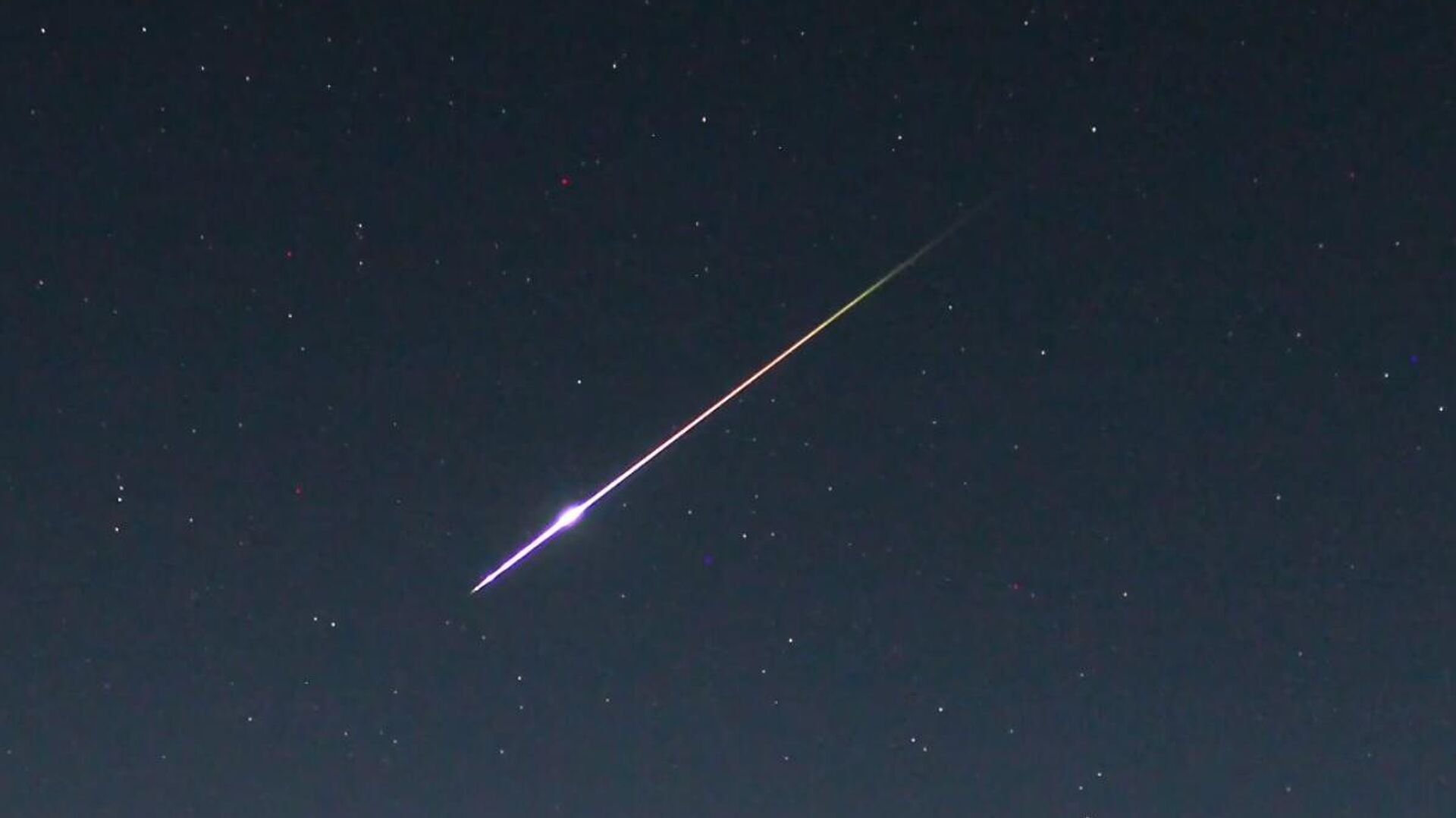https://sputnikglobe.com/20221122/meteor-flashes-across-torontos-night-sky-before-crashing-into-earth-near-niagara-falls-1104520518.html
Meteor Flashes Across Toronto’s Night Sky Before Crashing Into Earth Near Niagara Falls
Meteor Flashes Across Toronto’s Night Sky Before Crashing Into Earth Near Niagara Falls
Sputnik International
The “fireball” marks the sixth time in history that a space object’s impact on Earth has been predicted before touching down on land. The European Space Agency... 22.11.2022, Sputnik International
2022-11-22T04:00+0000
2022-11-22T04:00+0000
2023-04-21T10:42+0000
viral
meteorite
meteor
space
science & tech
https://cdn1.img.sputnikglobe.com/img/07e6/0b/12/1104354536_0:59:1199:733_1920x0_80_0_0_893ead45a6e8e83dd080702ee43b791b.jpg
A meteor, which resembled a shooting star, passed through the night sky of Toronto early on Saturday morning. The meteor, named #C8FF042, was detected hours before it entered the atmosphere, a rare chunk of time to receive such a notice of an object before it enters Earth’s sphere, said Sarah Rugheimer, an associate professor of astrophysics at York University.The meteor, which measured about 3.2 feet in diameter, became a virtual “fireball” as it soared over residents’ homes after it first entered Earth's atmosphere at 3:27 a.m. Eastern Standard Time over Brantford, Ontario, the Minor Planet Center reported.Thirty-three reports were made to the American Meteor Society (AMS) as the fireball was witnessed soaring across the skies of Maryland, New York, Ohio, Pennsylvania and Ontario.The fireball was brighter than the planet Venus in the morning or evening sky, said AMS. A fireball—or shooting star—is a term given to meteors exceptionally bright and can be seen over a large area."Objects causing fireballs are usually not large enough to survive passage through the Earth's atmosphere intact, although fragments, or meteorites, are sometimes recovered on the ground," said NASA.Since 2008, five other objects have been detected by astronomers before striking earth as a result of improved technology and global collaboration, said the ESA. The agency added that the capability to detect objects entering Earth’s atmosphere is “rapidly improving.”The meteor was first detected by the Mount Lemmon Survey near Tucson, Arizona and landed near Niagara Falls where it may be discoverable said Mike Hankey, a meteorite hunter with AMS.“There is a chance if there are meteorites that survived that they might be recoverable near Grimsby, Ontario, or St. Catharines, Ontario, near the Niagara Falls area,” Hankey said.Between 40 and 100 tons of space material strike Earth every day said the ESA, but most of these particles are very small. The agency, which is developing new telescopes so it can see a wider range of objects, also has a mission to prepare for "asteroid deflection missions" in the event that a large object may impact Earth, or the cases of smaller objects, warn people to stay away from their windows which may break during an explosion.
Sputnik International
feedback@sputniknews.com
+74956456601
MIA „Rosiya Segodnya“
2022
Mary Manley
https://cdn1.img.sputnikglobe.com/img/07e6/01/0b/1092187887_0:0:2048:2049_100x100_80_0_0_0c2cc4c84f89aff034cc55bb01fb6697.jpg
Mary Manley
https://cdn1.img.sputnikglobe.com/img/07e6/01/0b/1092187887_0:0:2048:2049_100x100_80_0_0_0c2cc4c84f89aff034cc55bb01fb6697.jpg
News
en_EN
Sputnik International
feedback@sputniknews.com
+74956456601
MIA „Rosiya Segodnya“
Sputnik International
feedback@sputniknews.com
+74956456601
MIA „Rosiya Segodnya“
Mary Manley
https://cdn1.img.sputnikglobe.com/img/07e6/01/0b/1092187887_0:0:2048:2049_100x100_80_0_0_0c2cc4c84f89aff034cc55bb01fb6697.jpg
viral, meteorite, meteor, space, science & tech
viral, meteorite, meteor, space, science & tech
Meteor Flashes Across Toronto’s Night Sky Before Crashing Into Earth Near Niagara Falls
04:00 GMT 22.11.2022 (Updated: 10:42 GMT 21.04.2023) The “fireball” marks the sixth time in history that a space object’s impact on Earth has been predicted before touching down on land. The European Space Agency (ESA) shared a video of the meteor which resembled a shooting star that passed through on Saturday morning, lighting up the CN tower as it soared through the sky.
A meteor, which resembled a shooting star, passed through the night sky of Toronto early on Saturday morning. The meteor, named #C8FF042, was detected hours before it entered the atmosphere, a rare chunk of time to receive such a notice of an object before it enters Earth’s sphere, said Sarah
Rugheimer, an associate professor of astrophysics at York University.
The meteor, which measured about 3.2 feet in diameter, became a virtual “fireball” as it soared over residents’ homes after it first entered Earth's atmosphere at 3:27 a.m. Eastern Standard Time over Brantford, Ontario, the Minor Planet
Center reported.
Thirty-three reports were made to the American Meteor Society (AMS) as the fireball was witnessed soaring across the skies of Maryland, New York, Ohio, Pennsylvania and Ontario.
The fireball was brighter than the planet Venus in the morning or evening sky, said AMS. A fireball—or shooting star—is a term given to meteors exceptionally bright and can be seen over a large area.
"Objects causing fireballs are usually not large enough to survive passage through the Earth's atmosphere intact, although fragments, or meteorites, are sometimes recovered on the ground," said NASA. Since 2008, five other objects have been detected by astronomers before striking earth as a result of improved technology and global collaboration, said the ESA.
The agency added that the capability to detect objects entering Earth’s atmosphere is “rapidly improving.”The meteor was first detected by the Mount Lemmon Survey near Tucson, Arizona and landed near Niagara Falls where it may be discoverable said Mike
Hankey, a meteorite hunter with AMS.
“There is a chance if there are meteorites that survived that they might be recoverable near Grimsby, Ontario, or St. Catharines, Ontario, near the Niagara Falls area,” Hankey said.
Between 40 and 100 tons of space material strike Earth every day said the ESA, but most of these particles are very small.
The agency, which is developing new telescopes so it can see a wider range of objects, also has a mission to prepare for "asteroid deflection missions" in the event that a large object may impact Earth, or the cases of smaller objects, warn people to stay away from their windows which may break during an explosion. 



